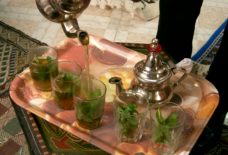Beirut to Build New Museum as Arab Art Booms
Jean Marc Nahas
Charles Khoury-Promenade
The Association for the Promotion and Exhibition of the Arts in Lebanon (APEAL) is looking to open a museum to display the art of many Arab and local artists in Beirut.
It is the love of life and attachment to it that distinguish the Lebanese. The country is without a president. Political problems abound, and there is neither security nor stability. Hezbollah targeted an Israeli military convoy along the northern borders with the occupied Palestinian territories, shaking security even further. Moreover, health, social and economic problems are on the rise, while administrative corruption seeps through the institutions. God only knows how many expired products are making their way to Lebanon.
The project is huge and costly, and the unstable security situation does not help. However, passion and love of life remain its basic motor elements. Since governmental support for creative projects is almost nonexistent in Lebanon, APEAL is planning to organize an auction on Jan. 30 at Casino du Liban. The auction will be led by Dalal Kadem from Christie’s London, and the proceeds will go to the construction of the museum. Twenty works of art by prominent Lebanese artists will be displayed. The artists include Diyaa Azawi, Chawki Chamoun, Abdel Rahman Katnani, Nadim Karam, Akram Zaatari, Marwan Sahmarani, Elie Kanaan, Paul Guiragossian, Alfred and Michel Basbous, Jamil Malaeb, Nabil Nahas Ayman, Osama Baalbaki, in addition to a piece called “Beirut” by the Turkish artist Azadi Koker.
Regional manager of Christie’s Auction House in the Middle East Michael Jeha told Al-Hayat that he came to Lebanon to support the auction at Casino du Liban this evening and to ensure reaching the desired outcome. He estimated the amount to be collected at more than $500,000, the proceeds of which will go to Beirut Contemporary project.
Jeha, who was born in England and has Lebanese roots, believes that building the museum is a serious opportunity to accommodate future artists in their country. It is also a new space to introduce art and increase awareness among people regarding the importance and confrontational role of arts on all levels. Moreover, it aims at luring novice local and foreign artists and attempts to harbor emerging talents and encourage creativity. This, in turn, helps develop society and attract tourists, notably art lovers.
When asked if he sees the situation in Lebanon fit to build a museum, Jeha answered, “It is no big secret that Lebanon’s security situation is unstable, but art mainly aims at uniting people rather than dividing them. Art lovers and supporters consider this their starting point to move forward, armed with the hope of completing the construction and gathering the necessary funds.”
Jeha also noted that Christie’s participation in the auction and its support for the museum stem from the bridges it has built with prominent artists across the Middle East, ever since it opened its branch in Dubai 10 years ago. The house has collaborated with famous Lebanese contemporary and modern artists.
He added that Lebanese art is among the most remarkable in the Middle East, owing that to its freedom of expression, emancipation from norms and traditions and openness to new and diverse cultures. At the same time, it clings to its identity and roots and compares the past and present within an impassioned artistic context.
Beirut Contemporary museum is scheduled to open its doors in 2020. It will be inaugurated at a historical and strategic intersection in Beirut, facing the National Museum, to connect the city’s different cultures. It will harbor several artistic works from Lebanon and the region and will host exhibitions and general dynamic programs involving Lebanese communities and international audience. The museum will be an independent organization that constitutes a hub for dialogue and education and caters to the needs of the local communities.
In a related context, Jeha said an auction will take place in Dubai (March 18), and it will include around 150 art pieces from several Arab countries. Prominent figures will be present, and sales are expected to exceed $9 million.
Lebanese art will make a remarkable appearance in the auction through 14 works by Lebanese painters. The question here is the following, “Might Christie’s open a branch in Lebanon?”
“Why not? But, it won’t be in the near future. We are based in Dubai, which is our foothold in the Middle East, as it has the necessary elements like security and stability. But, we are also present everywhere. I personally travel a lot to the Arab countries to give artistic conferences and communicate with artists in these countries,” Jeha said.
When asked about the strategy Christie’s adopts to choose the works participating in the auction, he replied, “Most often, the works are done by prominent artists, but this does not rule out the role of new talents also. We are always on the lookout for new talents through our galleries or interaction with professional artists.”
Jeha believes that the art market in Dubai is constantly evolving. It started out only 10 years ago, but there is gradual improvement, despite some factors related to norms and traditions, like displaying an art piece depicting a nude girl.
The chef d’oeuvres that will be on display in the auction include “Jabal al-Mahamel 2” painting, which is one of the most famous Middle Eastern masterpieces. The Palestinian plastic artist Suleiman Mansour had painted the original version in 1973 to express his tight relationship with his town. Then, he painted the second version in 2005. The painting depicts an old Palestinian man carrying a heavy burden on his shoulders in the form of a human eye. In the middle of the eye, the painting shows the Dome of the Rock (shrine), which represents the rights of the Palestinian people, their suffering, their heritage and history and their attachment to their identity and to Jerusalem.
Read more: http://www.al-monitor.com/pulse/culture/2015/02/lebanon-contemporary-art-museum.html#ixzz3Qh5uwcWN



